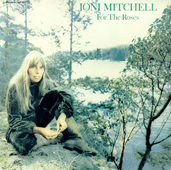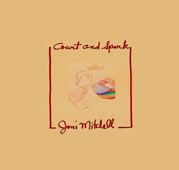The second dimension given to her work by her music arises from Mitchell's pioneering attitude. The innovative musical requirements that she experimented by the mid 1970s cleared the path for Jazz-Fusion and for a posterior, unlimited use by others of the musical genre called "World Music" -at that time, mostly a blend between African and Latin rhythms. Fellow composers, singers and musicians successfully followed Mitchell's move in the 1980s – artists such as Paul Simon (with Graceland), Peter Gabriel (with most of his post-Genesis albums), and Sting (mainly with his solo outputs after he departed from The Police).
Presumably originating from the Folk-Song scene (regimented by the likes of Judy Collins, Buffy Sainte Marie, Joan Baez or Laura Nyro), Joni Mitchell excelled in foreign fields where no one was expecting her to blossom. She escaped the labels with which these artists were being stamped, and thus thwarted a similar classification. Perhaps, the true reason of this being that she never really belonged to that scene, as she consistently repeated she never did, whenever she was put into that category by some critics.
The first hint of this rebellion to standards and formatting was to claim, (against all odds, one might be tempted to add) that she was first and foremost a painter when everyone saw her as being "just" a musician... She purposely muddied the waters. And when some filed her a bit too quickly in the Folk-Song drawer of "confessional" expression (indeed her first albums dusted and oxygenated so wonderfully the genre, from Song to a Seagull in 1968 to Blue in 1971), she printed on the music of For the Roses (1972), a "Rock" turning point that would culminate in 1973 with the release of Court and Spark.
Thus, the profession of faith contained in Cactus Tree (the song that closes her 1968 first album, Song to a Seagull, where a blunt Joni Mitchell asserts with poise that, in terms of love, her numerous and simultaneous lovers are losing their time waiting for someone who is "So busy being free"), relates equally to her art, underscoring the absolute coherence between the life style of the private character, and the philosophy of the artist. Both intending to be free to experiment in whatever fields they please -love, and art.
Because it is unquestionably freedom that drives Joni Mitchell to change gear as soon as the wedding with Rock n' Roll is consumed. When she was anointed in 1974 as "Queen of Rock n' Roll" by the profession, after releasing Court & Spark (and after its million sales in the U.S. alone), the Canadian was already elsewhere. This genre was deserted by the artist, drawn once more to the freedom provided by Jazz. A fascination that had been prefigured with subtle touches in her previous work. Some segments in that period's compositions figure as yesteryear pebbles left as clues for what was to come... One thinks especially of the use of the clarinet in For Free, from Ladies of The Canyon in 1970. In retrospect, it is also as interesting as it is moving to note that it is Joni Mitchell's sharp clear-sightedness and insight about North-American society’s values which got her interested in Jazz, and made her move towards that discipline. A society where money and sex are the ultimate benchmarks. Where "what-you-look-like-is-what-you-are", and where Eternal Youth’s dictatorship prevails, extended at any cost. On the contrary, Jazz seemed to be the only discipline apart from Painting, where she stated that she could "age gracefully with dignity". This when she was still only thirty years old.
© Jacques Benoit. Design, works, photographies and texts by Jacques Benoit and under the author’s copyright. Except when derived from other sources and then mentioned as such.

